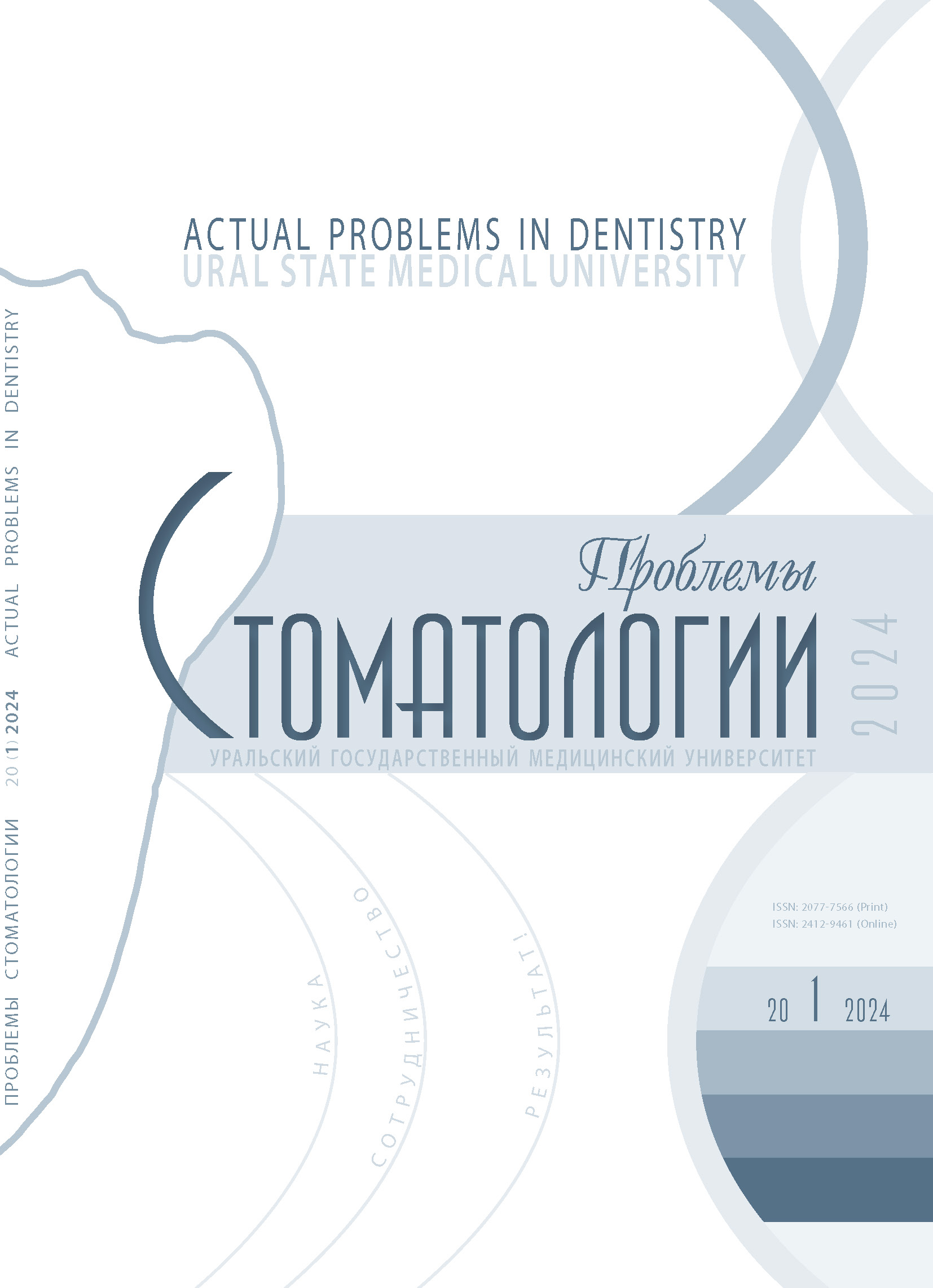Stavropol, Stavropol, Russian Federation
Stavropol, Stavropol, Russian Federation
Stavropol, Stavropol, Russian Federation
Stavropol, Stavropol, Russian Federation
Stavropol, Stavropol, Russian Federation
Vladikavkaz, Vladikavkaz, Russian Federation
UDC 616.31
Objective. To study the dental pathology frequency and structure of clinical polymorphism among respondents in adolescence and 1st period of adulthood studying at universities in Stavropol. Methodology. 508 respondents aged 17–35 years according to the Gurov V.A. (2018) classification of human age periodization were examined clinically, by questionnaire and 3D-biometrically. Therapeutic, orthopedic, orthodontic and gnathological complaints were identified when filling out the proposed express dental health card for a first-year students. Using virtual dynamic 3D-reformats of diagnostic jaw models, the types of occlusal relationships of dentitions and the types of dentitions shape anomalies (V-shaped, saddle-shaped, triangular, trapezoidal, asymmetrical) with a distal relationship were determined. Results. The dental pathology frequency of occurrence and structure of clinical polymorphism in respondents of adolescence and 1st period of adulthood with complete and incomplete dentitions were diagnosed in descending order as follows: anomalies of occlusion without gnathological disorders, various localization defects of dentitions, anomalies of occlusion with gnathological disorders, defects of dentitions with anomalies of occlusion, defects of dentitions with gnathological and occlusal disorders and defects of dentitions only with gnathological disorders. The structure of occlusion anomalies was diagnosed in descending order as follows: distal occlusion, cross occlusion, mesial and vertical incisal occlusion. Physiological occlusion was the least during the study. Conclusion. Structured data from questionnaires, clinical examinations and 3D-biometric data from shape analysis of the virtual dynamic 3D-reformats of diagnostic jaw models can be used in conducting epidemiological studies, simplifying diagnosis, prognosis, archiving and increasing the efficiency of complex dental treatment.
first-year student dental health express-card, dental pathology frequency of occurrence, dental pathology clinical polymorphism structure, CBCT, 3D-CBCT reformat, occlusion anomalies, distal occlusion, dental arch shape anomalies, respondents
1. Vakushina, E.A., Bragin E.A., Grigorenko P.A., Klemin V.A., Maylyan E.A., Vorozhko A.A., Kubarenko V.V. Propedevticheskiy kurs po ortopedicheskoy stomatologii i ortodontii. Uchebnoe posobie. Stavropol' : Izdatel'stvo StGMU. 2022:172. [E.A. Vakushina, E.A. Bragin, P.A. Grigorenko, V.A. Klemin, E.A. Majlyan, A.A. Vorozhko, V.V. Kubarenko. Propaedeutic course in orthopedic dentistry and orthodontics. Tutorial. Stavropol : Publishing house StGMU. 2022:172. (In Russ.)]. https://www.elibrary.ru/item.asp?id=49874163
2. Voskanyan A.R., Ayupova F.S., Alekseenko S.N. Zubochelyustnye anomalii i faktory riska u detey Krasnodarskogo kraya. Ortodontiya. 2019;3(87):4-8. [A.R. Voskanyan, F.S. Ayupova, S.N. Alekseenko. Dentoalveolar anomalies and risk factors among children of Krasnodar region. Orthodontics. 2019;3(87):4-8. (In Russ.)]. https://www.elibrary.ru/item.asp?id=41155081
3. Gurov V.A. Hronobiologiya. Vozrastnaya periodizaciya. Universum: Himiya i biologiya, elektronnyy zhurnal. 2018;4(46):7-12. [V.A. Gurov. Chronobiology. Age periodization. Universum : Chemistry and biology, electronic journal. 2018;4(46):7-12. (In Russ.)]. https://www.elibrary.ru/item.asp?id=32756461
4. Pod red. chlen. korr. RAN, prof. Persina L.S. Ortodontiya. Nacional'noe rukovodstvo v 2-h tomah. Moskva : GEOTAR-Media. 2020:680. [Ed. L.S. Persin. Orthodontics. National guideline. Moscow : GEOTAR-Media. 2020:680. (In Russ.)]. DOI:https://doi.org/10.33029/9704-5408-4-1-ONRD-2020-1-304.
5. Pod red. Lebedenko I.Yu., Arutyunova S.D., Ryahovskogo A.N. Ortopedicheskaya stomatologiya. Nacional'noe rukovodstvo. Moskva : GEOTAR-Media. 2019:824. [Eds. I.Yu. Lebedenko, S.D. Arutyunov, A.N. Ryahovskij. Prosthetic dentistry. National guideline. Moscow : GEOTAR-Media. 2019:824. (In Russ.)]. https://www.rosmedlib.ru/book/ISBN9785970449486.html
6. Postnikov M.A. Ortodontiya. Etiologiya, patogenez, diagnostika i profilaktika zubochelyustnyh anomaliy i deformaciy. Uchebnoe posobie. Samara : Izdatel'stvo OOO «Izdatel'sko-poligraficheskiy kompleks «Pravo». 2022:345. [M.A. Postnikov. Orthodontics. Etiology, pathogenesis, diagnosis and prevention of dental anomalies and deformities. Tutorial. Samara : Publishing house LLC Publishing and printing complex Pravo. 2022:345. (In Russ.)]. https://samsmu.ru/files/news/2023/0106/book_orthodontia.pdf
7. Ryzhova I.P., Maksimova V.M., Gontarev S.N., Bulgakova D.H. Analiz faktorov, vliyayuschih na kachestvo i dolgovechnost' fiksacii nes'emnyh konstrukciy zubnyh protezov (obzor literatury). Vestnik novyh medicinskih tehnologiy, elektronnyy zhurnal. 2023;30(2):53-57. [I.P. Ryzhova, V.M. Maksimova, S.N. Gontarev, D.H. Bulgakova. Analysis of factors affecting the quality and fixation of fixed dentures (literature review). Journal of new medical technologies, eDition. 2023;30(2):53-57. (In Russ.)]. https://www.elibrary.ru/item.asp?id=54040029
8. Hadzhaeva P.G., Grigorenko M.P., Vakushina E.A., Grigorenko P.A. Rasprostranennost' razlichnyh form anomaliy okklyuzii v period smeny zubov u detey g. Ctavropolya. Ortodontiya. 2022;3(99):78-79. [P.G. Hadzhaeva, M.P. Grigorenko, E.A. Vakushina, P.A. Grigorenko. Prevalence of various forms of occlusion anomalies during the period of tooth change in children of Stavropol. Orthodontics. 2022;3(99):78-79. (In Russ.)]. https://www.elibrary.ru/item.asp?id=50253542
9. Campbell S., Millett D., Kelly N., Cooke M., Cronin M. Frankel 2 appliance foe Phase 1 treatment of Class II division 1 malocclusion in children and adolescents: A randomized clinical trial // The Angle Orthodontist. – 2020;90(2):202-208. https://doi.org/10.2319/042419-290.1
10. Giudice A.Lo., Nucera R., Ronsivalle V., Grazia C.Di., Rugeri M., Quinzi V. Enhancing the diagnosis of maxillary transverse discrepancy through 3-D technology and surface-to-surface superimposition. Description of the digital workflow with a documented case report // European Journal of Pediatric Dentistry. – 2020;21(2):213-218. https://www.doi.org/10.23804/ejpd.2020.21.03.11
11. Grigorenko M.P., Bragin E.A., Vakushina E.A., Karakov K.G., Dmitrienko S.V., Bragin A.E., Grigorenko P.A., Khadzhaeva P.G. Variability of morphometric indicators of the craniofacial complex in patients with distal occlusion according to 3d cephalometry data // Medical News of North Caucasus. – 2022:17(2): 174-178. https://doi.org/10.14300/mnnc.2022.17042
12. Hadadpour S., Noruzian M., Abdi A.H., Baghban A.A., Nouri M. Can 3D imaging and digital software increase the ability to predict dental arch form after orthodontic treatment? // Am. J. Orthod. Dentofacial. Orthop. – 2019;156(6):870-877. https://doi.org/10.1016/j.ajodo.2019.07.009
13. Kelley N., Tabbaa S., Vezina G.C., El-Bialy T. Cone-beam Computed Tomography Analysis of the Relationship between the Curve of Spee and the Collum Angle of Mandibular Anterior Teeth // The Journal of Contemporary Dental Practice. – 2021;22(6) 599-604. https://pubmed.ncbi.nlm.nih.gov/34393113/
14. Mohan A., Babu H., Balakrishnan N. Correction of posterior crossbite in adolescents and young adults with class I, class II and class III malocclusion // International Journal of Dentistry and Oral Science. – 2020;7(10):869-871. https://doi.org/10.19070/2377-8075-20000172
15. Rao A., Badavannavar A., Acharya A. An orthodontic analysis of the smile dynamics with videography // Journal of Oral Biology and Craniofacial Research. – 2021:11(2):174-179. https://doi.org/10.1016/j.jobcr.2021.01.001



















